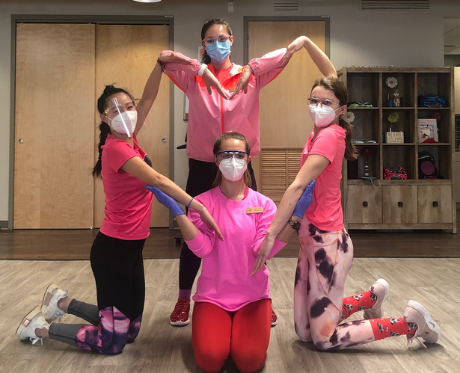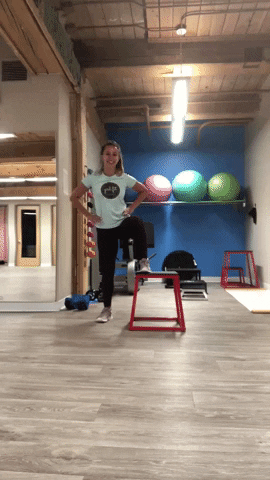



Last week I had the pleasure of speaking virtually with students at Newton North High School during their Women in STEM Day. The physical therapy profession has evolved and changed a great deal in its 100+ years of existence. Most importantly, the profession has done a huge push to bring more science, research, and evidence into physical therapy practice. The Foundation for Physical Therapy Research has provided over 20 million dollars to physical therapy research. Also, to become a physical therapist you now must earn a Doctor of Physical Therapy degree, which typically contains a research component.
I spoke with the students at Newton North about the science behind a few things they likely know physical therapists do – choosing exercises, correcting form, and clearing patients to return to sport. Though most people know that physical therapists do these things, we all know advice about exercising can come at you from a million different sources. Who hasn’t had the stranger next to them at the gym give them unsolicited tips on how to perform an exercise?! So, I wanted to share with the students the science behind the evidence based decisions physical therapists make every day for our patients.

Let’s use the example of glute exercises – mostly because anyone who’s ever done a Girl Fit Strength & Stretch class with me knows they are my favorite! Start by thinking of a glute exercise you’ve been given in a workout class, by a coach, or when looking up exercises online. There seem to be a million options! Or maybe everyone just tells you to do squats! As physical therapists we put a great deal of thought (and science) into our exercise choices.
For example, say we are choosing a glute exercise for a patient with patellofemoral pain (knee pain). We know we want to address our patient’s lower extremity mechanics when squatting, running, and jumping so we would like to strengthen the glutes. The glute muscles are hip external rotators, extensors, and abductors. But wait! There’s another muscle that lives right next door to the glutes, called the tensor fascia latae (TFL), that we might need to take into account as well. The TFL is an abductor like the glutes, but is also an internal rotator. In addition, it has been shown to create a lateral pull on the patella (knee cap).1 We know that excessive hip internal rotation and lateral displacement of the patella have been associated with knee pain or patellofemoral pain.1 So, we might want to choose an exercise which has high activation of the glutes, but not necessarily the TFL. So, what do we do?
We turn to the research – the science of physical therapy! Selkowitz, Beneck, and Powers1, looked at muscle activation with fine wire electrodes in the TFL, gluteus medius, and gluteus maximus during a variety of different glute exercises. These exercises included sidelying hip ABD, clam, hip hike, bridges, lunges, donkey kicks, side steps, squats, and step ups.1 They were looking for the highest ratio between the activation of the glutes and the activation of the TFL. What do the results tell is?
The gluteal- to-TFL muscle activation index was highest for the clam (115), sidestep (64), unilateral bridge (59), and both quadruped exercises (50).1 So, those may be glute exercise we would start with or work toward to strengthen the glutes with our patient who is experiencing knee pain. This also the kind of thought we put into the exercises we choose for our group classes, wellness visits, and injury prevention programs. In our group classes we take evidence based exercises, put them to music, and have a blast working out with friends!

Like choosing exercises, knowing correct form while working out can also feel a little overwhelming. You may have even had your form corrected in contradictory ways by different sources. I wanted to share with you just one small example of a form correction which may seem arbitrary but is backed up by science. Box jumps are a fun exercise to work on strength, agility, and plyometrics and there are lots of corrections an athlete might receive. One lesser known form correction is adjusting your trunk position upon landing.
According to physical therapy researcher Dr. Christopher Powers, landing from a jump with the trunk flexed resulted in 28% less quadriceps activation when compared to landing with the trunk more erect.2 Who would have thought your chest position could impact your quad activation?! But, your physical therapist likely has a good reason for wanting to adjust your chest position and the forcefulness of your quad contraction. Research and science drives your physical therapist’s decisions, even when you least expect it!

Clearance for returning to sport can be an emotional topic for athletes and, as a sports medicine clinic, we do our best to keep our athletes participating in as many aspects of their sport as we can. However, our top priority is the safety of our patients. Thus, having evidence based return to sport metrics is essential. At Girl Fit we try to always take the extra time to educate our patients on the criteria and objective measures that we will use to help us determine when they can safely return to sport. And we like to explain the science behind those decisions, as well.
Let’s take the example of return to sport following ACL reconstruction surgery and rehab. Dr. Lynn Snyder Mackler has done extensive research on return to sport following ACL rehab. In a study by her research team in 2016, knee function was assessed with the Knee Outcome Survey-Activities of Daily Living Scale, global rating scale of function, and quadriceps strength and hop test symmetry.3 Hop tests are an example of how physical therapists use math on a daily basis as well. The hop tests include a 1 hop for distance, 3 hop for distance, 3 zig zag hops for distance, and a timed 6 meter hop test. Each are compared to your uninvolved leg. Three reps of each test are performed and the averages are divided to create a leg symmetry index. Return to sport passing criteria in this study were defined as scores >90 on all tests, failure as failing any.3
So, what does the science tell us about passing those tests? 38.2% of those who failed the return to sport criteria in this study suffered re-injuries versus 5.6% of those who passed.3 That’s a big difference! More symmetrical quadriceps strength prior to return also significantly reduced the knee re-injury rate.3 And, the re-injury rate was significantly reduced by 51% for each month return to sport was delayed until 9 months after surgery, after which no further risk reduction was observed.3
Though we know it can still be emotional, we hope that knowing there is research, evidence, and science behind our decisions to clear an athlete to return to sport helps our patients understand and best protect their bodies.

Almost exactly a year ago, the Girl Fit physical therapists jumped head first into the technology of physical therapy when we switched our entire practice from in person visits to Telehealth physical therapy. Thanks to Telehealth we were able to see our patient’s faces, observe their gait, correct their form, and demonstrate exercises. But there’s even more to it than that! Through some amazing apps we are even able to measure joint angles, range of motion, and quantify body mechanics and gait deviations virtually. With a quick screen share, our patients can see those angles too. We’re so grateful for this technology and for our governor’s mandate of insurance coverage for Telehealth physical therapy visits because we likely wouldn’t have made it through this year otherwise.
There are several other very cool uses of technology in the profession of physical therapy. In the field of prosthetics, prosthetists and physical therapists utilize physics, biomechanics, and robotics to significantly improve patient quality of life following limb loss. Physical therapists and researchers can use the technology of force plates to measure ground reaction forces in the lumping, landing, and sport specific skills of athletes. And, physical therapists are even utilizing virtual reality in rehabilitation to help motivate and treat patients with a variety of musculoskeletal and neurologic conditions.
We love the amount of science, math, and research we get to use in our jobs, but we also cherish the relationships we get to develop with our patients as physical therapists. It really is a special profession and I love walking into my job each day. I might be biased, but we have the BEST patients in the world at Girl Fit Physical Therapy!

Thank you again to Newton North High School for inviting me to speak at Women in STEM day. We are so happy to have the opportunity to support our community and keep the girls, women, and everyone in Newton injury-free!
Kate Hamilton, PT, DPT
Orthopedic Clinical Specialist
To schedule a virtual or in person physical therapy or Wellness Visit, email us at office@girlfitPT.com or give us a call at 617-618-9290.
References
1. Selkowitz, DM, Beneck, GJ, and Powers, CM. Which exercises target the gluteal muscles while minimizing activation of the tensor fascia lata? Electromyographic assessment using fine-wire electrodes. J Orthop Sports Phys Ther 43: 54–64, 2013.
2. Powers CM. The influence of abnormal hip mechanics on knee injury: a biomechanical perspective. J Orthop Sports Phys Ther. 40:42-51.
3. Grindem H, Snyder-Mackler L, Moksnes H, et al. Simple decision rules reduce reinjury risk after anterior cruciate ligament reconstruction: the Delaware–Oslo cohort study. Br J Sports Med Published Online First: 9 May 2016.

